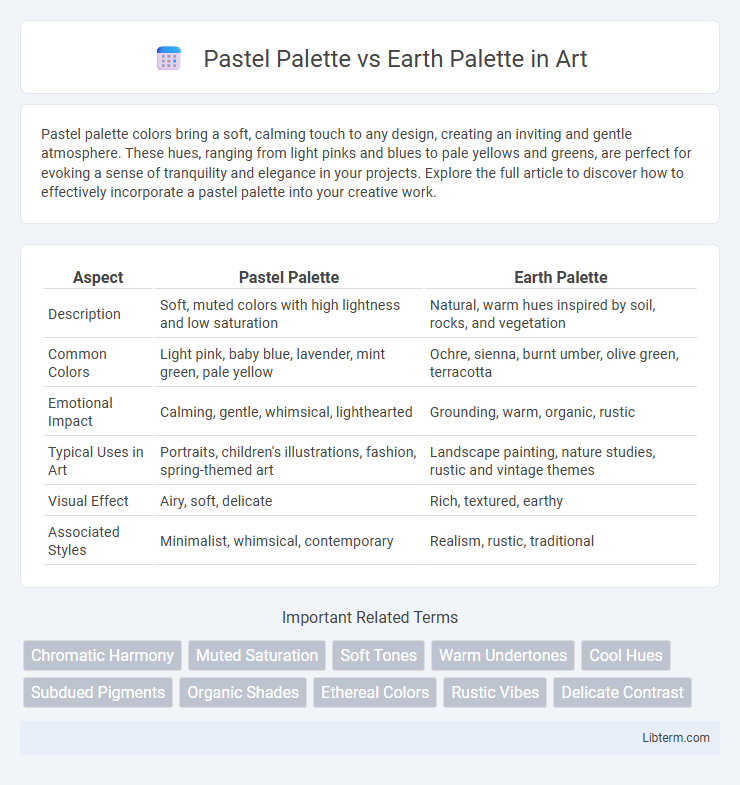Pastel palette colors bring a soft, calming touch to any design, creating an inviting and gentle atmosphere. These hues, ranging from light pinks and blues to pale yellows and greens, are perfect for evoking a sense of tranquility and elegance in your projects. Explore the full article to discover how to effectively incorporate a pastel palette into your creative work.
Table of Comparison
| Aspect | Pastel Palette | Earth Palette |
|---|---|---|
| Description | Soft, muted colors with high lightness and low saturation | Natural, warm hues inspired by soil, rocks, and vegetation |
| Common Colors | Light pink, baby blue, lavender, mint green, pale yellow | Ochre, sienna, burnt umber, olive green, terracotta |
| Emotional Impact | Calming, gentle, whimsical, lighthearted | Grounding, warm, organic, rustic |
| Typical Uses in Art | Portraits, children's illustrations, fashion, spring-themed art | Landscape painting, nature studies, rustic and vintage themes |
| Visual Effect | Airy, soft, delicate | Rich, textured, earthy |
| Associated Styles | Minimalist, whimsical, contemporary | Realism, rustic, traditional |
Introduction to Color Palettes
Pastel palettes feature soft, muted hues with high lightness and low saturation, creating a calming and delicate aesthetic ideal for spring or feminine designs. Earth palettes consist of natural, warm tones like ochre, terracotta, and moss green, evoking a grounded, organic feel suited for rustic or eco-friendly themes. Choosing between pastel and earth palettes depends on the emotional tone and context desired in visual projects.
Defining Pastel Palette
Pastel Palette features soft, muted colors like pale pinks, light blues, and gentle lavenders that evoke a calm, airy aesthetic often used in spring and feminine design themes. Earth Palette consists of rich, warm tones such as browns, ochres, and deep greens, reflecting natural elements and grounding visuals. Defining Pastel Palette emphasizes its light saturation and high brightness levels, creating a soothing and delicate visual experience distinct from the grounded and robust Earth Palette.
Defining Earth Palette
The Earth Palette consists of warm, muted tones inspired by natural elements such as soil, clay, and foliage, emphasizing rich browns, deep greens, and soft beige hues. Its color scheme creates a grounded and organic aesthetic that promotes a sense of calm and connection to nature. Unlike the light and airy Pastel Palette, the Earth Palette offers depth and warmth, making it ideal for interiors or designs seeking a cozy, rustic atmosphere.
Historical Context and Origins
Pastel palettes emerged in the 18th century, associated with Rococo art and favored by French painters like Jean-Baptiste-Simeon Chardin for their soft, delicate hues symbolizing elegance and refinement. Earth palettes trace back to prehistoric times, utilizing natural pigments such as ochre, sienna, and umber, foundational in cave paintings and early human cultural expression. The contrasting origins highlight pastel palettes' link to aristocratic aesthetics versus earth palettes' primacy in human artistic development.
Psychological Effects of Each Palette
Pastel palettes evoke calmness and softness, often associated with feelings of tranquility, innocence, and relaxation due to their light, desaturated hues. Earth palettes, composed of warm browns, greens, and muted tones, promote stability, groundedness, and comfort by reflecting natural elements and organic materials. Psychological studies indicate pastel colors can reduce stress and anxiety, while earth tones enhance feelings of security and connection to nature.
Popular Uses of Pastel Palette
Pastel palettes are widely favored in design and art for creating soft, calming visuals that evoke a sense of tranquility and innocence, making them popular in baby products, wedding invitations, and spring-themed marketing. These gentle hues enhance user experience in digital interfaces by promoting readability without overwhelming the eyes, often utilized in lifestyle branding and social media aesthetics. Compared to earth palettes, which emphasize natural and grounding tones for outdoor and eco-friendly themes, pastel palettes excel in conveying lightness and whimsy.
Popular Uses of Earth Palette
Earth palettes are commonly used in interior design and fashion to evoke warmth and natural serenity, featuring shades like terracotta, olive green, and sandy beige. These colors enhance rustic and bohemian aesthetics, creating cozy, grounded spaces and outfits. Popular in eco-friendly branding and outdoor gear, earth tones convey sustainability and a connection to nature.
Pastel vs Earth Palette in Modern Design
Pastel palettes in modern design create a soft, airy atmosphere with muted, light tones that evoke calmness and sophistication, ideal for minimalist and Scandinavian styles. Earth palettes, featuring rich browns, ochres, and greens, provide a warm, grounded feel that connects interiors to nature and sustainability trends. Both palettes enhance spatial perception but serve different emotional purposes, with pastels emphasizing freshness and earth tones promoting comfort and eco-consciousness.
Tips for Choosing Between Pastel and Earth Palettes
Choosing between pastel and earth palettes depends on the mood and purpose of your design or artwork. Pastel palettes, characterized by soft, light hues like lavender, mint, and blush, evoke a calm, airy, and youthful atmosphere ideal for spring themes and minimalist aesthetics. Earth palettes feature warm, muted tones such as terracotta, olive green, and beige, creating a grounded, natural, and cozy feel perfect for rustic interiors and sustainable branding.
Conclusion: Finding Your Perfect Color Palette
Choosing between a pastel palette and an earth palette depends on the mood and atmosphere you want to create; pastel colors evoke softness and playfulness with hues like baby pink, mint green, and lavender, while earth tones offer warmth and grounding using shades such as terracotta, olive, and ochre. Consider the context of your project--pastels are ideal for light, airy designs, making spaces feel spacious and youthful, whereas earth palettes provide a natural, cozy vibe suited for more organic, sophisticated aesthetics. Your perfect color palette aligns with your emotional goals and brand identity, balancing visual appeal and psychological impact.
Pastel Palette Infographic

 libterm.com
libterm.com